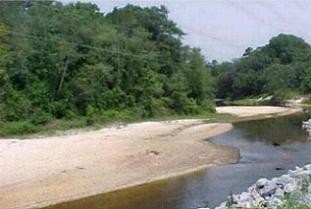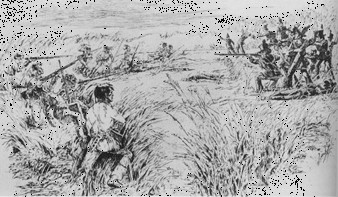The Battle of Burnt Corn Creek
Introduction
Text-to-speech Audio
Images
Burnt Corn Creek

A depiction of the Battle of Burnt Corn Creek

Backstory and Context
Text-to-speech Audio
The Battle of Burnt Corn Creek took place July 27th, 1813 and was an early clash of the Creek War (1813-14). The war itself was a result of increased tensions between the American settlers and Creek (or Muscogee) Indians who lived in Alabama and Georgia. Influenced by the Shawnee war leader Tecumseh, a faction of Creeks arose known as the “Red Sticks” (named for their red war clubs). Fueled by religious prophecy, the Red Sticks believed the Creeks should reject the influences of American culture and welcomed war with the United States. Not all Creeks embraced Red Stick views, however, and the Creek nation descended into civil war between the Red Sticks and Creeks friendlier to the United States.
In need of weapons, ammunition, and gunpowder, the Red Sticks reached out to Great Britain and Spain for assistance. Britain, fighting the United States in the War of 1812, was eager to help and instructed Spanish officials in Florida to quietly lend aid to the Red Sticks. In July 1813, Red Stick leader Peter McQueen led a party of approximately 100 warriors south from Alabama toward Spanish controlled Pensacola, where they could purchase gunpowder and shot. The Spanish gave this ammunition to his party for "hunting purposes" but continued to supply the Red Sticks whenever a new group would arrive.
The Red Sticks’ journey to Florida and their acquisition of military supplies did not go unnoticed by local American militia; panic swept American settlements in the region. Colonel James Caller determined to attack McQueen’s party and interdict the flow of supplies between Spanish Florida and Creek Alabama. Gathering a force of between 100-200 local militia, Caller’s men reached the vicinity of Burnt Corn Creek on July 27. Scouts indicated that McQueen’s force was in the vicinity.
Seizing the opportunity, Caller attacked the unsuspecting Indians around noon. Caught off guard, the Red Sticks were driven back into nearby swamps within an hour. broke for the nearby trees in what appeared to the Americans to be a full blown rout. Believing they had won, the Americans began looting the Indians’ camp and securing the pack horses carrying the supplies from Pensacola.
The Red Sticks, however, were regrouping and advanced again on the Americans, who were now unprepared themselves for an attack. The Red Sticks began to surround the lead party of Americans, and other militiamen refused to engage, focused still on the pack horses. As the Red Sticks pressed their advantage, an American militia officer shouted for a retreat. Some militia kept up a tough rearguard, but the Americans were ultimately broken and forced to flee. The militia suffered at least two dead and a dozen wounded; the Red Sticks suffered perhaps 10 killed and wounded.
Though a relatively small skirmish, the Battle of Burnt Corn Creek had tremendous implications. Although the Red Sticks were hostile to American settlers, they did not believe themselves to be at war with the United States. To Native eyes, the attack of Caller’s militia was unprovoked. Yet the battle seemed to indicate that a war had finally arrived, and the Red Sticks would retaliate by attacking Fort Mims at the end of August. The capture of Fort Mims and the massacre of American settlers and U.S.-friendly there forced the United States to invade Creek Nation. In sum, Burnt Corn Creek sparked the Creek War of 1813-1814.
Today, the exact location of the battle is unknown, but it is thought to have occurred in Escambia or Conecuh Counties.
Sources
1. James P. Kaetz. "Battle of Burnt Corn Creek." August 3, 2015. Encyclopedia of Alabama. Web. Accessed November 25, 2020. http://encyclopediaofalabama.org/article/h-3081
2. John R. Elting. Amateurs, to Arms! A Military History of the War of 1812. New York: Da Capo Press, 1995.
3. Howard T. Weir, III. A Paradise of Blood: The Creek War of 1813-1814. Yardley, PA: Westholme Publishing, 2016.
4. Joel W. Martin. Sacred Revolt: The Muskogees' Struggle for a New World. Boston: Beacon Press, 1991.
5. Donna R. Causey. "Burnt Corn, Alabama, a Community Older than the United States." Alabama Pioneers. Web. Accessed November 26, 2020. https://www.alabamapioneers.com/burnt-corn-alabama-commnity-older-united-states/
